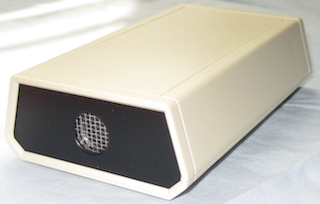Introduction
Software
Applications
Detectors
GM-10
GM-45
GM-90
Accessories
Test Source
Battery Box
Coincidence Box
Anti-Coincidence
GMI Interface
Air Sampler
Download
Linux
Users Group
Interfacing
Raspberry Pi
Random Numbers
Safety Uses
Radiation Info
Specifications
FAQ
Articles
Experiments
Rad Map
Links
Secure Order
Detectors
Contact
Three types of radioation - Alpha, Beta, Gamma
There are three primary types of radiation:
- Alpha - these are fast moving helium atoms. They have high energy, typically in the MeV range,
but due to their large mass, they are stopped by just a few inches of air, or a piece of paper.
- Beta - these are fast moving electrons. They typically have energies in the range of a
few hundred keV to several MeV. Since electrons are might lighter than helium atoms, they are
able to penetrate further, through several feet of air, or several millimeters of plastic or
less of very light metals.
- Gamma - these are photons, just like light, except of much higher energy, typically from
several keV to several MeV. X-Rays and gamma rays are really the same thing, the difference is
how they were produced. Depending on their energy, they can be stopped by a thin piece of aluminum
foil, or they can penetrate several inches of lead.
In this experiment, we study the penetrating power of each type of radiation. For this test, we used an old radium coated watch hand, obtained from, where else, eBay.
The radium is an alpha source, and we also get several beta and gamma emissions as well from daughter products. This hand is about 50 years old, so we should get a nice mixture of radiations. This makes it an ideal source to use for these experiments.
We first placed the radium watch hand about 1 cm from the face of a GM-45 detector. We obtained an average of 44307 CPM. A GM-10 detector would also work, and costs about half as much.
Next, we placed a single piece of paper in between the watch hand and detector. The rate dropped to 35111 CPM. The paper blocked all of the alpha rays.
We then put a second piece of paper in between, the counts dropped to 31583 CPM. With a third piece of paper, 27977 CPM. We are now blocking beta rays with our pieces of paper, each piece blocks some more of the radiation.
With 3 mm of steel (1/8 inch), the reading went down to 394 CPM. Background is about 50 CPM, so at this point we're picking up some of the gammas from the source.

Click here for more information about the GM-10 Nuclear Radiation Detector